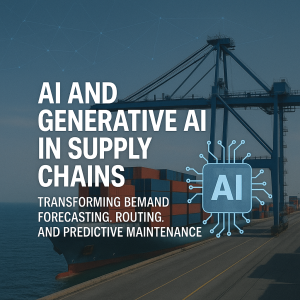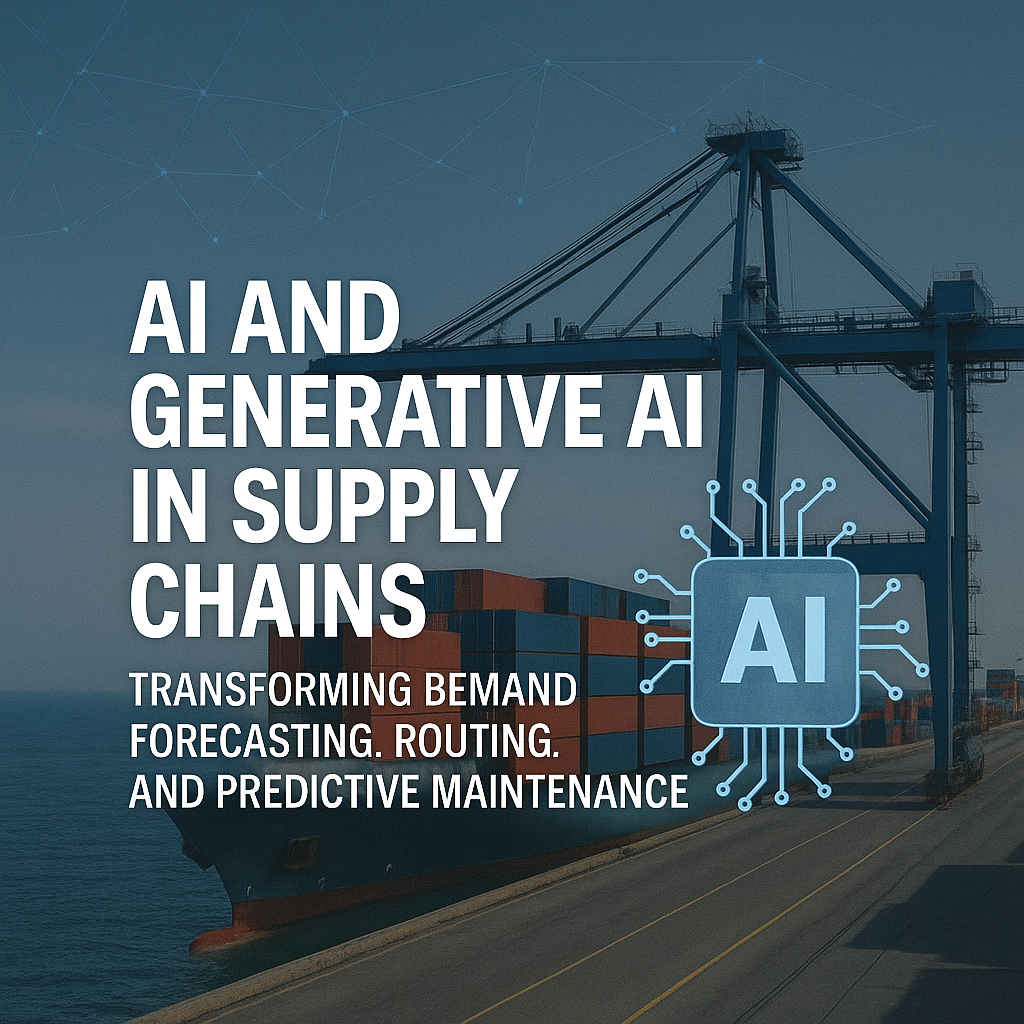
Discover how AI and Generative AI are revolutionising global supply chains. From demand forecasting to predictive maintenance and maritime routing, explore real-world applications, challenges, and future trends in this in-depth guide.
Why AI in Supply Chains Matters Today 🌍
The global supply chain has always been a delicate balance of demand, production, and delivery. But in recent years, unprecedented disruptions — from the COVID-19 pandemic to the Suez Canal blockage and geopolitical conflicts — have exposed vulnerabilities that can ripple through economies in hours. According to the World Bank (2023), supply chain disruptions contributed to nearly 1.5% of lost global GDP in 2021–22.
In this context, Artificial Intelligence (AI), and more recently Generative AI (GenAI), have emerged as powerful tools. No longer confined to research labs, AI is now steering container vessels, predicting demand for spare parts, optimising cargo routing, and even drafting complex logistics documentation.
For maritime and logistics professionals, the shift is both exciting and daunting. Imagine a future where your vessel’s route is adjusted in real time by an AI considering weather, piracy alerts, and carbon emissions — or where generative models forecast container imbalances before they disrupt port operations. That future is not decades away; it’s unfolding today.
The Rise of AI and Generative AI in Maritime Supply Chains
Artificial Intelligence in supply chains is not new. Machine learning has been used since the 2010s for demand planning and predictive maintenance. What has changed in the last 3–5 years is the maturity of algorithms, the scale of available data (via IoT sensors, AIS ship tracking, and satellite monitoring), and the ability of Generative AI to simulate, forecast, and create novel solutions.
-
Traditional AI: Focuses on pattern recognition, optimisation, and anomaly detection.
-
Generative AI (GenAI): Goes a step further — creating synthetic scenarios, generating new routing strategies, writing documents, or simulating outcomes that haven’t yet occurred.
According to McKinsey & Company (2023), supply chains that adopt AI can reduce forecasting errors by 20–50%, cut inventory costs by 15–30%, and improve service levels by up to 65%.
For the maritime industry, where margins are tight and risks are global, these numbers are transformative.
Why AI Matters in Modern Maritime Operations
AI’s integration into maritime supply chains matters for three reasons:
-
Resilience: With climate change intensifying storms and port congestion becoming routine, AI helps anticipate disruptions before they spiral.
-
Sustainability: The IMO GHG Strategy (2023) mandates carbon intensity reduction. AI-powered routing can cut fuel use by 5–10%, reducing both costs and emissions.
-
Efficiency: Labour shortages, container imbalances, and volatile demand make human forecasting alone insufficient. AI augments human decision-making with predictive analytics.
Put simply: AI is not replacing maritime professionals — it’s giving them sharper tools to navigate uncertainty.
Key Use Cases of AI and Generative AI in Supply Chains
Demand Forecasting and Inventory Optimisation
Accurate demand forecasting is the holy grail of logistics. Overestimate, and warehouses overflow with unused stock. Underestimate, and factories halt due to missing components.
-
How AI helps: Machine learning models process real-time sales, macroeconomic trends, and even social media sentiment to forecast demand more accurately.
-
Generative AI advantage: GenAI can create scenario-based forecasts — “What if global oil prices spike by 20%?” or “What if a port strike lasts two weeks?” — and simulate ripple effects across the chain.
📌 Case in Point: During COVID-19, AI-driven forecasting helped Maersk adjust container deployment across Asia-Pacific, minimising backlogs in congested ports (Maersk, 2021).
Smart Routing and Maritime Navigation
Routing is no longer just about distance. It’s about balancing fuel efficiency, emissions, piracy risks, congestion, and even regulatory constraints.
-
Traditional AI: Optimises based on real-time AIS (Automatic Identification System) and weather forecasts.
-
Generative AI: Simulates multiple routing scenarios, suggesting alternatives that balance safety, time, and emissions.
📌 Example: Wärtsilä’s Fleet Operations Solution integrates AI with satellite data, offering real-time route optimisation that can cut fuel consumption by up to 7% (Wärtsilä, 2022).
Predictive Maintenance of Vessels and Port Equipment
A single engine failure mid-voyage can cost hundreds of thousands in delays. Predictive maintenance powered by AI is becoming a standard in shipping.
-
AI role: Monitors vibration, pressure, and temperature data to predict failures before they occur.
-
Generative AI role: Generates maintenance schedules, simulates part failures, and creates digital twins of ship systems to test interventions virtually.
📌 Real-world case: DNV reported (2023) that predictive maintenance reduced unplanned downtime in container fleets by 30%.
Port Operations and Container Management
Congested ports like Los Angeles or Shanghai can lose millions daily due to delays. AI is helping here too:
-
Yard management: AI predicts container dwell times, optimising stacking and crane operations.
-
Customs and paperwork: Generative AI drafts documents, reducing clerical workload.
-
Traffic flow: AI monitors truck and barge arrivals, smoothing intermodal transitions.
📌 Example: The Port of Rotterdam’s “Digital Twin” project uses AI to model port operations, achieving 10% faster turnaround times (Port of Rotterdam, 2022).
Risk Management and Resilience Planning
Generative AI models are particularly strong at stress-testing. For instance, they can simulate what happens if the Panama Canal faces drought (as it did in 2023), or if geopolitical sanctions hit major oil shipping routes.
This proactive resilience planning is critical. UNCTAD (2023) estimated that 80% of world trade by volume is carried by sea, meaning even a short disruption has outsized consequences.
Sustainability and Carbon Reduction
AI-driven optimisation supports compliance with the IMO’s Carbon Intensity Indicator (CII) and EU Emissions Trading System (ETS).
-
AI use: Route optimisation, slow steaming guidance, and cargo load balancing.
-
Generative AI use: Simulating multi-year carbon reduction strategies for fleets, balancing economics with compliance.
📌 Example: Inmarsat (2023) showed that digital fuel optimisation platforms can save up to 10% in CO₂ emissions per voyage.
Challenges and Barriers to Adoption
Despite the promise, AI in maritime supply chains faces hurdles:
-
Data Silos: Many shipping companies still store data in disconnected systems, limiting AI’s effectiveness.
-
Trust and Transparency: Crew and managers may distrust “black box” algorithms.
-
Cybersecurity Risks: More connectivity means greater vulnerability to cyberattacks.
-
Skill Gaps: Seafarers and port staff need training to interpret AI-driven insights.
-
Costs: Initial investments in sensors, software, and training are significant, even if ROI arrives later.
Solutions? Partnerships with technology providers, shared digital platforms (like IMO’s GISIS), and stronger cyber-standards (per IACS Unified Requirements E26/E27) are key steps forward.
Case Studies: AI in Action
Case Study 1 – Maersk’s AI-Powered Scheduling
Maersk uses AI to forecast cargo demand and dynamically allocate vessels. This has reduced empty container repositioning by 16%, a massive efficiency gain (Maersk Annual Report, 2022).
Case Study 2 – Port of Singapore’s Smart Nation Integration
The Maritime and Port Authority of Singapore integrates AI to monitor ship arrivals, weather, and logistics partners. Result: reduced waiting times and increased throughput, even with record volumes (MPA Singapore, 2022).
Case Study 3 – Wärtsilä’s Smart Maintenance
Wärtsilä’s predictive engine monitoring systems saved one LNG carrier operator USD 500,000 annually in avoided breakdowns (Wärtsilä Insights, 2023).
Future Outlook: Where AI and GenAI Are Heading
By 2030, expect:
-
Fully autonomous AI routing agents negotiating canal slots and berth times.
-
Generative AI assistants drafting compliance reports for IMO conventions.
-
Wider adoption of digital twins for entire supply chains — ship to shore to hinterland.
-
Green AI applications, aligning shipping with IMO’s 2050 net-zero goal.
According to Allied Market Research (2024), the global AI in logistics market could reach USD 67 billion by 2032, with maritime as a major contributor.
FAQ: AI in Maritime Supply Chains
1. Will AI replace jobs in shipping?
Not entirely. AI augments human decision-making. For example, a routing AI suggests options, but captains still make the final call.
2. How reliable is predictive maintenance?
Studies by DNV and Lloyd’s Register show predictive models can detect failures weeks before traditional inspections.
3. Is Generative AI safe for maritime use?
Yes, if paired with strong cybersecurity and human oversight. GenAI should support — not replace — regulatory compliance.
4. Which companies are leading in maritime AI?
Key players include Wärtsilä, Maersk, Inmarsat, IBM, and startups like Thetius and MarineTraffic AI Labs.
5. Can AI really reduce emissions?
Yes. Route optimisation and slow steaming guided by AI can reduce emissions by 5–10%, supporting compliance with IMO’s CII and EU ETS.
6. How can smaller shipping firms adopt AI?
Through shared platforms, cloud-based services, and pilot projects supported by classification societies and P&I clubs.
Conclusion: The New Compass of Global Trade
AI and Generative AI are no longer optional — they’re becoming the compass of global supply chains. From forecasting demand to guiding vessels across oceans, these tools are already reshaping how the maritime world works.
For professionals, students, and enthusiasts, the message is clear: learning AI literacy is as essential as learning navigation once was. Companies that embrace AI now will not only sail smoother waters but also lead in sustainability, resilience, and competitiveness.
The oceans of trade are vast and unpredictable — but with AI, supply chains finally have a smarter way to navigate them.
References
-
BIMCO & ICS. (2021). Seafarer Workforce Report. ICS
-
DNV. (2023). Predictive Maintenance in Shipping. DNV
-
IMO. (2023). IMO GHG Reduction Strategy. IMO
-
Inmarsat. (2023). Digital Fuel Optimisation Report. Inmarsat
-
Maersk. (2021). AI in Container Allocation. Maersk
-
McKinsey & Company. (2023). AI in Supply Chains Report. McKinsey
-
Port of Rotterdam. (2022). Digital Twin Project. Port of Rotterdam
-
Wärtsilä. (2022). Fleet Operations Solution. Wärtsilä
-
UNCTAD. (2023). Review of Maritime Transport. UNCTAD

